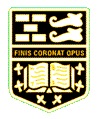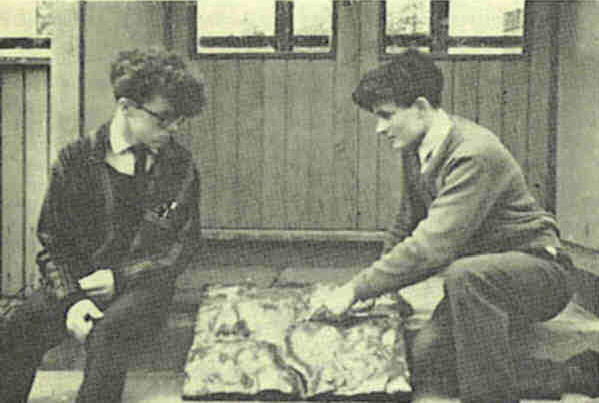|
LOCHEARNHEAD 1964
ON TUESDAY, 16th June at 6 p.m., all the boys who had been selected to go to Lochearnhead assembled in the gymnasium to
receive our briefing from Mr. Newton, who was in charge of all arrangements. This included a list of items we were to take,
including rucksacks and anaraks.
Friday, 19th June. During the afternoon we took all our kit down to the gymnasium where it was checked and packed properly.
Tentage, cooking utensils, maps, compasses, and all the general equipment was packed into bundles for easy loading on to the two
mini-buses, which had been hired for our week's expedition. Mr. Newton and Tony, who is a member of the Hertford Rover Crew,
and who had given up a week of his holidays to act as official examiner for the Duke of Edinburgh Award Scheme, arrived with
our transport at 8 p.m., and we were on our way by 8.30 p.m. There was a terrific thunderstorm which we managed to keep up
with all the way to the Scottish border, and then it stopped perhaps its passport was not in order. During our 416-mile journey we
made three stops for petrol and meals, which were haversack rations plus, of course, a good cup of tea. It was quite tiring for we
boys who were just riding, so goodness knows how Mr. Newton and Tony felt, driving all the way with no one to take over.
Saturday, 20th June. We arrived at Lochearnhead at 11 a.m., and unpacked the vans and stored our gear in the places at the station.
Mr. Newton prepared dinner for us, which was very good. After we had eaten he gave us our first lecture which was about the
station and how it had been made into a mountain training base. Following this we were given lectures on hygiene, camp and
mountain clothing, care of our feet, and all the advice about looking after ourselves when out on our expeditions. This was all
very interesting but of course we forgot a lot of the things we had been told when we got out on our own.
Sunday, 21st June. We did not rise too early as we were all very tired after our night and day journey, and after breakfast we had a
good look round the camp and the neighbourhood before we had dinner at i p.m. After dinner we all got into one van and
Mr. Newton and Tony took us round some of the higher mountains, and when we came to one which was not so high we all got
out and climbed part of the way up. It all looked very easy but, as we found out, it was very tiring. We then drove fairly slowly
back to camp where we enjoyed a nicely prepared tea. After tea we were shown how to read a map and find direction with the aid
of a compass. We then split up into groups and planned our routes from the camp. Again we found planning these journeys took
much longer than we had anticipated.
Monday, 22nd June. We got up quite early so that we could get ready for our hike, which was to take three days and nights. Each
group was ready to start at 12 noon and away we went in our different directions, and I am only able to describe ours, the 'Gold'
journey.
We travelled about 15 miles and reached our check point at Calender in good time, had a good wash and a hot meal, and were not
late to bed as we were all very tired after a hard day.
Tuesday, 23rd June. We overslept and were not up until 9 o'clock, but even so we were on our way by n o'clock, and as the day was
very hot we wished we had wakened earlier, so that we did not have the hard climb in the full sun. However, we reached our
destination at Dalckonzie, near the River Earn, which is about 5 miles from the base, one hour late we had underestimated the
distance. When we eventually got to our camping area there was a strong wind blowing which made tent pitching quite a hazard.
However, in due course we had managed it and got ourselves a good hot meal, and were very thankful to creep into our beds and
sleep.
Wednesday, 24th June. We got under way a little earlier this day, although the journey was not so long as the previous two days,
we had only to travel about 12 miles to Eildreach, 2,099 ft above sea-level, but once again it was very hot, and we were glad to
stop for a couple of 'brew-ups' on route, but we eventually reached our destination about 8 p.m. We had a real 'slap-up' meal and
then had a good wash in the loch. We did not get to bed until 11.30 p.m.
Thursday, 25th June. Breakfast this morning was scrambled egg and bacon, which gave us a good start before returning to base
and we arrived there just at midday and in time for dinner. After dinner all the Gold group went up the mountain opposite the base
while the other two groups went on a compass hike.
In the evening we were all assembled in the station and Mr. Newton held a post mortem on the camps, pointing out the faults we
had made, as well as the good points. We then made up our log books and by 10.30 p.m. we were all in bed for our last night's
sleep at the station for 1964.
Friday, 26th June. We were up early and after breakfast we started to clear up the station and load up for the journey back. In view
of the high standard set by our boys last year, we were all determined not to let the side down by leaving any rubbish around, and
so we cleared the whole area up very thoroughly.
We finally left the station about 4 p.m. and started southwards, seeing some of the lovely sights of the highlands and some of the
hills we had climbed earlier in the week. It was an even more tiring journey for Mr. Newton and Tony coming home, and we had
to make frequent stops while they collected themselves with a few minutes sleep. We eventually arrived at the School at 10 a.m.
on Saturday morning, very tired and very hungry, but nevertheless very happy to have had the opportunity of going on this trip.
We would like to take this opportunity of thanking everyone who was concerned in arranging this expedition, especially
Mr. Wheatley for allowing us to go, and Tony for coming along as examiner, and of course Mr. Newton himself who must have
worked harder than all of us put together, as well as having the responsibility of the twelve boys who were more often out of sight,
but we know we were never out of mind. The following is a list of boys and their groups:
Gold: J. Brown, P. Gregory, D. Langler, R. Hendry.
Silver: R. Bowden, B. Smith, R. McNamara, A. Cummings.
Bronze: T. Hill, R. Nairn, B. Foote, P. Salkeld.
D. LANGLER, J. BROWN Goldonian Winter 1964
|


